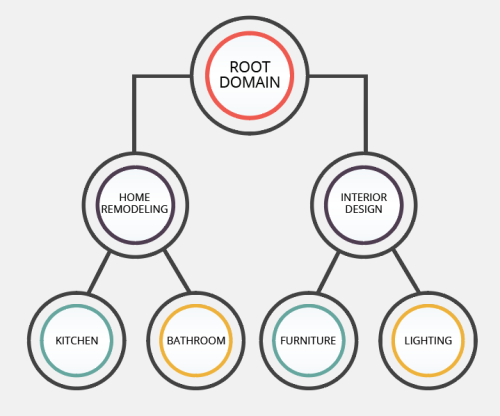Creating An SEO Silo Structure For Your Website
SEO siloing is an innovative internet marketing strategy that organizes a website into precisely-planned themes to improve a site’s search engine ranking. Simply put, an SEO silo better organizes the content on a website so search engines have an easier time identifying the core themes in the content. By applying this strategy to your website content, you can effectively raise your position for target search terms and enhance your site’s visibility in search terms.
In this comprehensive guide, we will explore what SEO siloing is, why it is important, and how you can use it to better your search engine ranking in the long run.
What Is SEO Siloing?
The term “SEO silo” refers to the process of grouping webpages that all relate to one central theme. Most websites will employ several silos in their search engine optimization strategies, but each silo has a focus subject, followed by a series of supporting webpages that remark on that subject. Think back to your college essays, where you wrote about a primary thesis backed by evidence, research, and expert commentary. Your silo follows the same pattern, only it is comprised of webpages rather than paragraphs.
Why Is Siloing Important For SEO?
Most websites consist of a series of unrelated webpages with no central theme. These may relate to the services a business provides or the types of products they sell online, but the pages themselves are not grouped together in a silo.
Search engines award websites that have high “keyword relevancy.” That means that websites that are well organized with strong support for central themes are ranked better than disorganized sites. If we look back on the reference of a college essay, an organized, well supported paper is more likely to get an “A” than a disorganized set of quotes, citations, and opinions that do not flow properly or do not back up the thesis. With the right keyword architecture and content structure for your website, you will have a much better chance at ranking well for the keywords you want to target.

Step-By-Step Guide For Creating An SEO Silo Structure For Your Website
Now that you understand what SEO siloing is and why it is an important search engine ranking strategy, follow the steps below to create effective keyword silos for your website.
Step 1 – Identify The Themes For Your Website
Identifying the central themes for your website is the fundamental step in creating SEO silos. In order to do this, you need to ask yourself the following questions:
- What are the central themes in your website right now?
- What themes do you want to target that your website is currently missing?
- What themes will your audience respond to the most?
- Can you convert the themes you have chosen into a clearly organized SEO campaign?
Google’s main objective is to connect searchers with high-quality content from experts in their fields. It is your job to establish yourself as an expert on a particular subject, which you can do through a well-implemented silo structure. Google’s algorithm rewards strong organization that points to an equally strong understanding of a particular topic. That topic will translate into the theme or themes for your website.
To better illustrate this idea, picture a basket filled with brown, white, and speckled eggs. If the eggs are all mixed together, you would only be able to label that as a “basket of eggs.” Sort the eggs into three separate baskets, and then you have a “basket of brown eggs,” a “basket of white eggs,” and a “basket of speckled eggs.” This gives you the chance to fit into three categories instead of one, but there is an even better way to maximize your category options. Put all three colors of eggs in the basket in siloed rows, and then you have the “basket of brown eggs,” “basket of white eggs,” and “basket of speckled eggs,” as well as the general category “basket of eggs.”
Your website should be arranged into themes similar to the basket of eggs listed above. Search engines will pick up on the individual themes of your silos, along with the general theme of your site as a whole, giving you access to the largest audience possible.
Step 2 – Implement A Physical Silo Structure
The easiest way to create a silo structure on your website is to adjust the directory to group pages together within the same silo. For example, let’s say you run a business selling donuts. You may have a silo for “cake donuts” and another silo for “raised donuts.” Your URLs for your cake donut silo may look something like this:
- com/cake-donuts/blueberry.html
- com/cake-donuts/old-fashioned.html
- com/cake-donuts/chocolate.html
- com/cake-donuts/sprinkle.html
- com/cake-donuts/cruller.html
As you can see, each webpage indicates that it falls under the “cake donuts” category, so search engines crawling the webpage will know that all of these pages are designed to support one central theme. At minimum, you should have five supporting webpages for every theme, in addition to the parent page for the theme.
NOTE: When you create multiple silos on the same website, it is important not to cross link them. For instance, if you have a page about chocolate cake donuts, you would not want to link it to your page about chocolate raised donuts. The only linking that should happen will be within the silo so search engines can easily distinguish one theme from the next. If you need to reference a page from a separate silo, include a link to the primary landing page of the silo, not a supporting page.

Alternate Step 2 – Implement A Virtual Silo Structure
In some instances, you may not be able to adjust your website’s directory to support a physical silo structure. The alternative to this is to create a virtual silo structure, where you strategically interlink your webpages to one another within the silo to show search engines that they are connected.
In the example above, you may still have a landing page for “cake donuts,” followed by supporting pages for “blueberry,” “old fashioned,” etc. All five of the supporting pages should link to the landing page, and the landing page should link to each of the supporting pages. In addition to that, each of the supporting pages should link to the other supporting pages within the same silo.
The easiest way to create this structure is to add a navigation list on the webpage that points people to other topics of interest within the same silo. Not only does this tie pages from the silo together with one another, but it also encourages users to continue their activity within the silo. Once again, this emphasizes which pages on your website are interconnected and helps search engines identify the prominent themes on your site.
Step 3 – Maintain, Expand, And Condense Your Silos
Creating a virtual or physical silo structure is the foundation of an SEO silo strategy. In order to capitalize on this opportunity though, you need to maintain and adjust your silos over time. Continue monitoring your market and your competitors so you can keep your silos in line with current trends. Here are some different ways you can maintain your SEO silos:
- Organize your silos into a pyramid structure consisting of primary silos and secondary silos. If you have a keyword pyramid for your website, your silo pyramid may reflect the themes from your keywords. If you have a simple silo structure to start with, you may only have a handful of primary silos to work with. You can break them into subcategories over time, which will turn into your secondary silos.
- Expand your silos as needed to meet fluctuations in the market. Whether you add new silos to your website over time or you simply build upon the ones you already have, the goal here is to saturate your site with valuable content that reflects what your target audience is searching for online.
- Don’t change too much too quickly. As with most marketing campaigns, it may take time for you to be able to see noticeable changes in your site traffic and page rankings as a whole after you expand an existing silo or build a new one. If you are adding new silos to your website, only add one or two at a time. If you are adding to successful themes, slowly work in the content so search engines can see that you are updating your website. This alone will improve your ranking.
- Modify, prune, or delete consistently unsuccessful silos from your website. Again, you need to do this slowly, especially if you operate in an industry that frequently fluctuates. Before you get rid of anything on your site, be sure that it is not going to hurt your ranking in the future. It may be better to adjust the silo to fit a new theme, rather than removing it from your website. You will have to use your best judgment to see what is right for your business.
- Check and recheck your silo integrity. In other words, keep an eye on how your webpages are interlinked with one another to ensure that your silos only link within themselves. Any interlinking that you do needs to point to the category page for the silo, not the supporting pages. Those should only point to other supporting pages within the silo and the landing page for that silo specifically.
With proper maintenance and a strong SEO silo architecture on your website, you can significantly improve the search engine ranking for your site’s target themes. Simultaneously, you can enhance the content organization for your website and put your business in a position of authority for specialized topics. Follow the guide above, and you can successfully silo your website and boost your visibility online.











